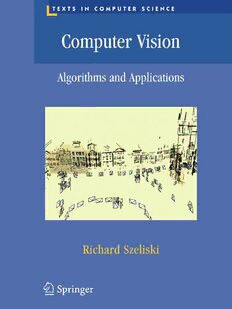Table Of ContentTexts in Computer Science
Editors
DavidGries
FredB.Schneider
Forfurthervolumes:
www.springer.com/series/3191
Richard Szeliski
Computer Vision
Algorithms and Applications
123
Dr. Richard Szeliski
Microsoft Research
One Microsoft Way
98052-6399 Redmond
Washington
USA
[email protected]
SeriesEditors
DavidGries FredB.Schneider
DepartmentofComputerScience DepartmentofComputerScience
UpsonHall UpsonHall
CornellUniversity CornellUniversity
Ithaca,NY14853-7501,USA Ithaca,NY14853-7501,USA
ISSN 1868-0941 e-ISSN 1868-095X
ISBN 978-1-84882-934-3 e-ISBN 978-1-84882-935-0
DOI 10.1007/978-1-84882-935-0
Springer London Dordrecht Heidelberg New York
BritishLibraryCataloguinginPublicationData
AcataloguerecordforthisbookisavailablefromtheBritishLibrary
LibraryofCongressControlNumber:2010936817
© Springer-VerlagLondonLimited2011
Apart from any fair dealing for the purposes of research or private study, or criticism or review, as
permittedundertheCopyright,DesignsandPatentsAct1988,thispublicationmayonlybereproduced,
stored or transmitted, in any form or by any means, with the prior permission in writing of the
publishers,orinthecaseofreprographicreproductioninaccordancewiththetermsoflicensesissuedby
theCopyrightLicensingAgency.Enquiriesconcerningreproductionoutsidethosetermsshouldbesent
tothepublishers.
Theuseofregisterednames,trademarks,etc.,inthispublicationdoesnotimply,evenintheabsenceofa
specificstatement,thatsuchnamesareexemptfromtherelevantlawsandregulationsandthereforefree
forgeneraluse.
Thepublishermakesnorepresentation,expressorimplied,withregardtotheaccuracyoftheinformation
containedinthisbookandcannotacceptanylegalresponsibilityorliabilityforanyerrorsoromissions
thatmaybemade.
Printedonacid-freepaper
SpringerispartofSpringerScience+BusinessMedia(www.springer.com)
Thisbookisdedicatedtomyparents,
ZdzisławandJadwiga,
andmyfamily,
Lyn,Anne,andStephen.
1 Introduction 1
Whatiscomputervision? • Abriefhistory •
Bookoverview • Samplesyllabus • Notation
n^ 2 Imageformation 27
Geometricprimitivesandtransformations •
Photometricimageformation •
Thedigitalcamera
3 Imageprocessing 87
Pointoperators • Linearfiltering •
Moreneighborhoodoperators • Fouriertransforms •
Pyramidsandwavelets • Geometrictransformations •
Globaloptimization
4 Featuredetectionandmatching 181
Pointsandpatches •
Edges • Lines
5 Segmentation 235
Activecontours • Splitandmerge •
Meanshiftandmodefinding • Normalizedcuts •
Graphcutsandenergy-basedmethods
6 Feature-basedalignment 273
2Dand3Dfeature-basedalignment •
Poseestimation •
Geometricintrinsiccalibration
7 Structurefrommotion 303
Triangulation • Two-framestructurefrommotion •
Factorization • Bundleadjustment •
Constrainedstructureandmotion
8 Densemotionestimation 335
Translationalalignment • Parametricmotion •
Spline-basedmotion • Opticalflow •
Layeredmotion
9 Imagestitching 375
Motionmodels • Globalalignment •
Compositing
10 Computationalphotography 409
Photometriccalibration • Highdynamicrangeimaging •
Super-resolutionandblurremoval •
Imagemattingandcompositing •
Textureanalysisandsynthesis
11 Stereocorrespondence 467
Epipolargeometry • Sparsecorrespondence •
Densecorrespondence • Localmethods •
Globaloptimization • Multi-viewstereo
12 3Dreconstruction 505
ShapefromX • Activerangefinding •
Surfacerepresentations • Point-basedrepresentations •
Volumetricrepresentations • Model-basedreconstruction •
Recoveringtexturemapsandalbedos
13 Image-basedrendering 543
Viewinterpolation • Layereddepthimages •
LightfieldsandLumigraphs • Environmentmattes •
Video-basedrendering
14 Recognition 575
Objectdetection • Facerecognition •
Instancerecognition • Categoryrecognition •
Contextandsceneunderstanding •
Recognitiondatabasesandtestsets
Preface
Theseedsforthisbookwerefirstplantedin2001whenSteveSeitzattheUniversityofWash-
ingtoninvitedmetoco-teachacoursecalled“ComputerVisionforComputerGraphics”. At
thattime,computervisiontechniqueswereincreasinglybeingusedincomputergraphicsto
createimage-basedmodelsofreal-worldobjects,tocreatevisualeffects,andtomergereal-
world imagery using computational photography techniques. Our decision to focus on the
applicationsofcomputervisiontofunproblemssuchasimagestitchingandphoto-based3D
modelingfrompersonalphotosseemedtoresonatewellwithourstudents.
Sincethattime,asimilarsyllabusandproject-orientedcoursestructurehasbeenusedto
teachgeneralcomputervisioncoursesbothattheUniversityofWashingtonandatStanford.
(ThelatterwasacourseIco-taughtwithDavidFleetin2003.) Similarcurriculahavebeen
adoptedatanumberofotheruniversitiesandalsoincorporatedintomorespecializedcourses
oncomputationalphotography.(Forideasonhowtousethisbookinyourowncourse,please
seeTable1.1inSection1.4.)
Thisbookalsoreflectsmy20years’experiencedoingcomputervisionresearchincorpo-
rateresearchlabs,mostlyatDigitalEquipmentCorporation’sCambridgeResearchLaband
atMicrosoftResearch. Inpursuingmywork, Ihavemostlyfocusedonproblemsandsolu-
tiontechniques(algorithms)thathavepracticalreal-worldapplicationsandthatworkwellin
practice. Thus,thisbookhasmoreemphasisonbasictechniquesthatworkunderreal-world
conditionsandlessonmoreesotericmathematicsthathasintrinsicelegancebutlesspractical
applicability.
Thisbookissuitableforteachingasenior-levelundergraduatecourseincomputervision
to students in both computer science and electrical engineering. I prefer students to have
either an image processing or a computer graphics course as a prerequisite so that they can
spendlesstimelearninggeneralbackgroundmathematicsandmoretimestudyingcomputer
visiontechniques. Thebookisalsosuitableforteachinggraduate-levelcoursesincomputer
vision(bydelvingintothemoredemandingapplicationandalgorithmicareas)andasagen-
eralreferencetofundamentaltechniquesandtherecentresearchliterature.Tothisend,Ihave
attemptedwhereverpossibletoatleastcitethenewestresearchineachsub-field,evenifthe
technicaldetailsaretoocomplextocoverinthebookitself.
Inteachingourcourses,wehavefounditusefulforthestudentstoattemptanumberof
smallimplementationprojects,whichoftenbuildononeanother,inordertogetthemusedto
workingwithreal-worldimagesandthechallengesthatthesepresent. Thestudentsarethen
askedtochooseanindividualtopicforeachoftheirsmall-group,finalprojects. (Sometimes
these projects even turn into conference papers!) The exercises at the end of each chapter
contain numerous suggestions for smaller mid-term projects, as well as more open-ended
x
problems whose solutions are still active research topics. Wherever possible, I encourage
studentstotrytheiralgorithmsontheirownpersonalphotographs,sincethisbettermotivates
them, often leads to creative variants on the problems, and better acquaints them with the
varietyandcomplexityofreal-worldimagery.
Informulatingandsolvingcomputervisionproblems,Ihaveoftenfounditusefultodraw
inspirationfromthreehigh-levelapproaches:
• Scientific: build detailed models of the image formation process and develop mathe-
maticaltechniquestoinverttheseinordertorecoverthequantitiesofinterest(where
necessary,makingsimplifyingassumptiontomakethemathematicsmoretractable).
• Statistical: useprobabilisticmodelstoquantifythepriorlikelihoodofyourunknowns
andthenoisymeasurementprocessesthatproducetheinputimages,theninferthebest
possibleestimatesofyourdesiredquantitiesandanalyzetheirresultinguncertainties.
Theinferencealgorithmsusedareoftencloselyrelatedtotheoptimizationtechniques
usedtoinvertthe(scientific)imageformationprocesses.
• Engineering: develop techniques that are simple to describe and implement but that
are also known to work well in practice. Test these techniques to understand their
limitation and failure modes, as well as their expected computational costs (run-time
performance).
Thesethreeapproachesbuildoneachotherandareusedthroughoutthebook.
Mypersonalresearchanddevelopmentphilosophy(andhencetheexercisesinthebook)
haveastrongemphasisontestingalgorithms. It’stooeasyincomputervisiontodevelopan
algorithmthatdoessomethingplausibleonafewimagesratherthansomethingcorrect. The
bestwaytovalidateyouralgorithmsistouseathree-partstrategy.
First,testyouralgorithmoncleansyntheticdata,forwhichtheexactresultsareknown.
Second, add noise to the data and evaluate how the performance degrades as a function of
noise level. Finally, test the algorithm on real-world data, preferably drawn from a wide
varietyofsources, suchasphotosfoundontheWeb. Onlythencanyoutrulyknowifyour
algorithm can deal with real-world complexity, i.e., images that do not fit some simplified
modelorassumptions.
Inordertohelpstudentsinthisprocess,thisbookscomeswithalargeamountofsupple-
mentarymaterial,whichcanbefoundonthebook’sWebsitehttp://szeliski.org/Book. This
material,whichisdescribedinAppendixC,includes:
• pointerstocommonlyuseddatasetsfortheproblems,whichcanbefoundontheWeb
• pointerstosoftwarelibraries,whichcanhelpstudentsgetstartedwithbasictaskssuch
asreading/writingimagesorcreatingandmanipulatingimages
• slidesetscorrespondingtothematerialcoveredinthisbook
• aBibTeXbibliographyofthepaperscitedinthisbook.
The latter two resources may be of more interest to instructors and researchers publishing
new papers in this field, but they will probably come in handy even with regular students.
Someofthesoftwarelibrariescontainimplementationsofawidevarietyofcomputervision
algorithms, which can enable you to tackle more ambitious projects (with your instructor’s
consent).
Preface xi
Acknowledgements
I would like to gratefully acknowledge all of the people whose passion for research and
inquiryaswellasencouragementhavehelpedmewritethisbook.
Steve Zucker at McGill University first introduced me to computer vision, taught all of
his students to question and debate research results and techniques, and encouraged me to
pursueagraduatecareerinthisarea.
TakeoKanadeandGeoffHinton,myPh.D.thesisadvisorsatCarnegieMellonUniversity,
taught me the fundamentals of good research, writing, and presentation. They fired up my
interest in visual processing, 3D modeling, and statistical methods, while Larry Matthies
introducedmetoKalmanfilteringandstereomatching.
DemetriTerzopouloswasmymentoratmyfirstindustrialresearchjobandtaughtmethe
ropes of successful publishing. Yvan Leclerc and Pascal Fua, colleagues from my brief in-
terludeatSRIInternational,gavemenewperspectivesonalternativeapproachestocomputer
vision.
DuringmysixyearsofresearchatDigitalEquipmentCorporation’sCambridgeResearch
Lab,Iwasfortunatetoworkwithagreatsetofcolleagues,includingIngridCarlbom,Gudrun
Klinker,KeithWaters,RichardWeiss,Ste´phaneLavalle´e,andSingBingKang,aswellasto
supervisethefirstofalongstringofoutstandingsummerinterns,includingDavidTonnesen,
SingBingKang,JamesCoughlan,andHarryShum. ThisisalsowhereIbeganmylong-term
collaborationwithDanielScharstein,nowatMiddleburyCollege.
AtMicrosoftResearch,I’vehadtheoutstandingfortunetoworkwithsomeoftheworld’s
bestresearchersincomputervisionandcomputergraphics,includingMichaelCohen,Hugues
Hoppe,StephenGortler,SteveShafer,MatthewTurk,HarryShum,Anandan,PhilTorr,An-
tonioCriminisi, GeorgPetschnigg, KentaroToyama, RaminZabih, ShaiAvidan, SingBing
Kang, Matt Uyttendaele, Patrice Simard, Larry Zitnick, Richard Hartley, Simon Winder,
DrewSteedly,ChrisPal,NebojsaJojic,PatrickBaudisch,DaniLischinski,MatthewBrown,
SimonBaker,MichaelGoesele,EricStollnitz,DavidNiste´r,BlaiseAguerayArcas,Sudipta
Sinha, Johannes Kopf, Neel Joshi, and Krishnan Ramnath. I was also lucky to have as in-
ternssuchgreatstudentsasPolinaGolland,SimonBaker,MeiHan,ArnoScho¨dl,RonDror,
AshleyEden,JinxiangChai,RahulSwaminathan,YanghaiTsin,SamHasinoff,AnatLevin,
Matthew Brown, Eric Bennett, Vaibhav Vaish, Jan-Michael Frahm, James Diebel, Ce Liu,
JosefSivic,GrantSchindler,ColinZheng,NeelJoshi,SudiptaSinha,ZeevFarbman,Rahul
Garg,TimCho,YekeunJeong,RichardRoberts,VarshaHedau,andDilipKrishnan.
WhileworkingatMicrosoft,I’vealsohadtheopportunitytocollaboratewithwonderful
colleaguesattheUniversityofWashington,whereIholdanAffiliateProfessorappointment.
I’m indebted to Tony DeRose and David Salesin, who first encouraged me to get involved
with the research going on at UW, my long-time collaborators Brian Curless, Steve Seitz,
Maneesh Agrawala, Sameer Agarwal, and Yasu Furukawa, as well as the students I have
hadtheprivilegetosuperviseandinteractwith,includingFre´dericPighin,Yung-YuChuang,
Doug Zongker, Colin Zheng, Aseem Agarwala, Dan Goldman, Noah Snavely, Rahul Garg,
and Ryan Kaminsky. As I mentioned at the beginning of this preface, this book owes its
inception to the vision course that Steve Seitz invited me to co-teach, as well as to Steve’s
encouragement,coursenotes,andeditorialinput.
I’m also grateful to the many other computer vision researchers who have given me so
manyconstructivesuggestionsaboutthebook,includingSingBingKang,whowasmyinfor-

